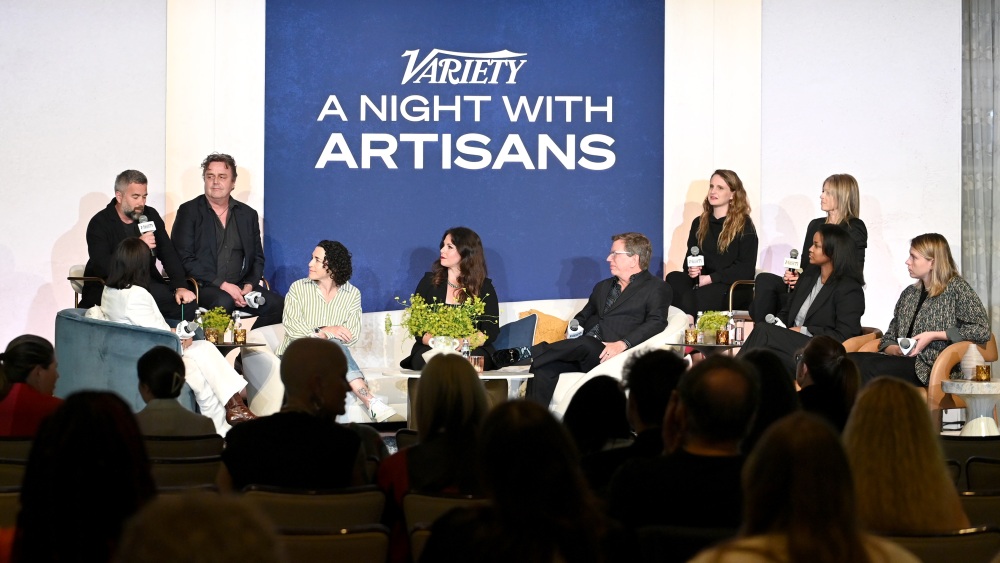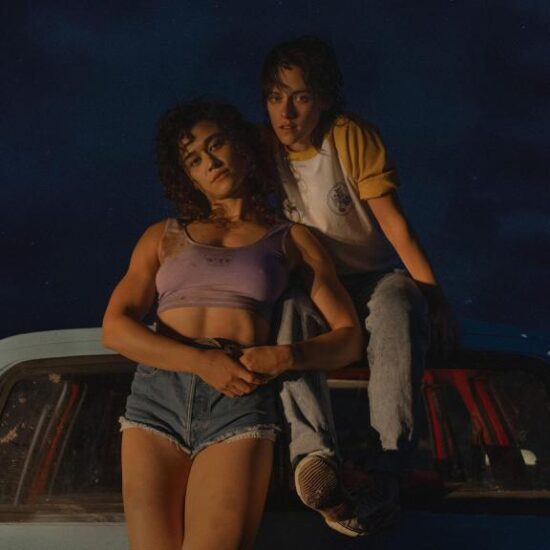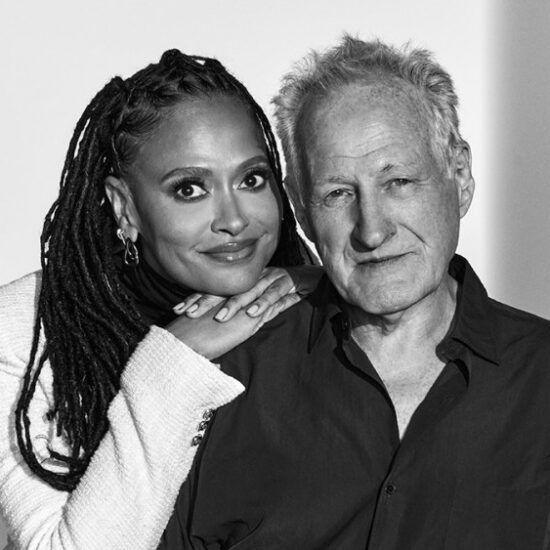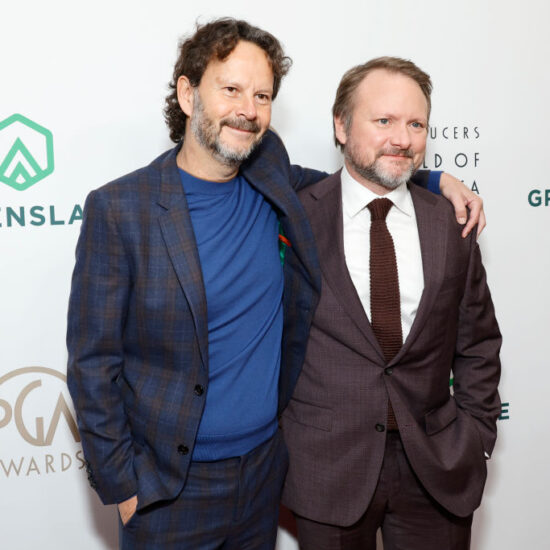
When making a television show, the creative team typically has an idea of who might play the major characters. But in the case of Freevee’s hit series “Jury Duty,” casting director Susie Farris had a unique challenge. When she sat down with producers Dave Bernad and Jake Szymanski, they explained, “We want you to find people that we don’t know. Really talented people. We’re casting a jury, and it’s sort of ‘The Joe Schmo Show’ meets ‘The Office,’” Farris said at Variety‘s “A Night With Artisans,” hosted by senior artisans editor Jazz Tangcay. Farris enjoyed the unexpected process, saying, “The beauty was that the actors basically had stories built around them, rather than vice versa.”
Bob Ducsay, editor for several of Rian Johnson’s films, had never worked in episodic television before signing on to his Peacock mystery series “Poker Face.” He was excited to learn something new and credited one vital partner in the transition: “My assistant who had done television before had to sort of teach me how the act breaks worked and how all that was put together.” But, with each episode being something of a feature film, he assured the audience, “I was pretty comfortable with it.”
One piece that added to the challenge was the arrangement of the production. “The thing that’s crazy is Episode 9 was the first episode [we shot]. I think that was very difficult on some level for everyone, because it’s an extremely dark episode. It’s very, very different than almost all of the others. The tone was a little bit difficult to navigate simply because we knew it was an outlier.” But Ducsay credited Johnson’s “great vision” and ability to reassure everyone that the episodes would work together. “I think they did pretty well,” he said.
Fellow editor Taylor Mason had a different type of challenge in working on the Netflix series “Dahmer – Monster: The Jeffrey Dahmer Story.” She needed to bring the story of the notorious serial killer to life without glamorizing him. Mason told the audience, “It was kind of a feat. Evan Peters is so charismatic and demands the scene. It was really the visual language that we leaned on, to kind of avoid glamorizing most of the characters in that series.”
To do this, Mason prioritized a more distant approach to the subject. “We lived in the wides a lot. We used a lot of static shots, and had a kind of measured pace throughout to allow us to tell the story without eliciting any empathy from the audience that generally comes with those closer tights,” as she emphasized the need for a more objective perspective.
Music is an essential piece in storytelling, and “P-Valley” music supervisor Sarah Bromberg has enjoyed getting to highlight female rap artists throughout the series. Citing creator Katori Hall, Bromberg said, “We have a really amazing guiding light in Katori, who grew up in Memphis near where our fictional town is set in northern Mississippi.”
Bromberg shared that female voices were a priority to Hall from the initial conversation, saying, “She had always wanted to make sure that the female voice is strong. Rap has very much been a male game for many years and she wanted to highlight some of the amazing female rappers that are coming up. Constantly throughout the process, she asks how many female rappers do we have so far? So she’s always counting to make sure that we’re really highlighting those voices.”
Sean Callery, a composer who scored the Fox anthology series “Accused,” had the opportunity to amplify voices in another way. In the episode “Ava’s Story,” directed by Marlee Matlin, Ava is played by deaf actress Stephanie Nogueras. Callery recalled an important rule he learned from his mentor, Mark Snow, years ago: “If you can’t hear the dialogue, no one’s watching.” This is a rule he has carried throughout his work on other series. When it came to “Accused,” he was drawn to the sounds of Ava’s expression. “Their language was a combination of hand movements, which had actual sound. You actually can hear the hands and friction,” he explained.
By listening to the sounds of Nogueras’ hands and mouth, he found, “It was beautiful. So we honored that and stayed out of the way of it.” He felt this was essential to the message of Ava’s story, saying, “At the end of the episode, she’s basically saying we’re born who we are. We’re fundamentally perfect just like that.”
In “A Small Light,” composer Ariel Marx used a small ensemble to tell the story of Miep Gies (Bel Powley) the woman who sheltered Anne Frank’s family from the Nazis. She envisioned the instrumentation as humble, noting, “It was a small ensemble. My influences were klezmer jazz, folk, classical, the amalgamation of the music that was playing there at the time.”
Marx’s small ensemble included violin, guitar, cello, clarinet, percussion and electronics. “It was very minimal,” she said. “But again, it was about an ordinary woman doing extraordinary things. And I really took that seriously in the ensemble. How big can we make this five-person band sound? And how can they become more complex and more brave as the series progresses? That was the guiding light for the palette.”
Working in another type of palette, art director Jacqueline Kay collaborated with production designers Michelle Yu and Cindy Chao to find the right designs and colors for their Disney+ series, “American Born Chinese.” Drawing from the graphic novel as well as Chinese symbolism, one important set — crafted for a gala — was designed as an octagon. Kay explained, “In Chinese mythology, the octagon shape is a symbol of balance, of harmony in the universe.” For this particular sequence, they designed a set with a stage in the middle for the host, “and then each of the different zones represented different pieces of Chinese mythology.”
Color was also essential to this process, as Kay told the audience, “It was the Jade Emperor, so we played in the jades and the pinks and the reds. What delineated the God realm versus the human realm, we brought a lot of pinks and reds into our trees with golds and jades, which are all heavily symbolized in Chinese folklore.”
Collaboration was key for cinematographer Ksenia Sereda when crafting scenes for HBO’s “The Last of Us.” In one vital early scene, our main characters are trying to escape from impending danger. The scene included elements of handheld photography, stunt choreography and timing. “We made a decision to do this scene mostly as a oner,” Sereda recalled. It was challenging, and she added, “You have to find the right timing for things inside of that.”
For Sereda, the decision to stay in one long shot helped the viewer stay connected to the characters, “to spend equal amount of time on the screen with characters as the viewer response in real life.” But this could not have worked if not for an organized production. “It was very vital for production to organize the working environment for everything to be safe, and to have enough time to rehearse and for our team to build everything perfectly.”
When asked about the most important collaborations on the set, “Mrs. Harris” director and executive producer Owen Harris explained, “There isn’t a single most important person. It’s absolutely a collaboration. And it’s absolutely about trying to join people together, making sure that if someone has a certain perspective, or an idea that that’s been being shared with someone else, that that person feels able to share their ideas back so that no one ends up feeling more important or less important.”













